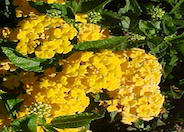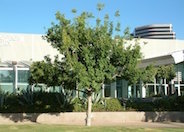
Common name:Red Yucca
Botanical name:Hesperaloe parviflora
Upright rosettes grow quickly to 3' x 5' wide. Spectacular accent for desert landscape. Leaves are dark green and strap-like. Coral red flower spikes emerge in spring & remain on plant till end of summer. Tolerates tough conditions including reflected heat and frost. Attracts humingbirds. Native to western Texas and northeastern Mexico.

Common name:Trailing Lantana
Botanical name:Lantana hybrid 'New Gold'
Evergreen groundcover forms a dark green mound 18" x 3'. Another reliable bloomer on and off throughout the year. Provides wonderful golden flowers, and benefits from deep, infrequent watering and some pruning. Attracts butterflies. May suffer some frost damage but will recover quickly. Very root hardy.

Common name:Live Oak
Botanical name:Quercus virginiana
Large evergreen tree growing to 40' x 50' at moderate rate. Dark green leaves are leathery and toothed. Flowers are nonshowy and appear in the spring. Accepts lawn conditions. Consider mature size. Accepts full sun. Native to the southeast U.S.

Common name:American Sycamore or Buttonwood
Botanical name:Platanus occidentalis
This beautiful deciduous tree rapidly reaches 75'-90' tall and 60'-70' wide. It starts out with a pyramidal habit and changes to a broad round crown later. Leaves are simple, green and can be 6"-10" long. Foliage turns yellow brown in fall. Red flowers appear in the spring but are not significant. The bark exfoliatesand can be reddish brown or gray. The peeling bark reveals a white inner bark. This tree needs moist, fertile, well-draining soil with full sun. Plant in large space areas such as parks.

Common name:Chinese Pistache
Botanical name:Pistacia chinensis
Deciduous tree with rounded crown 40' x 35'. Its leaves have 10-16 leaflets, and the striking fall coloring arrives in beautiful shades of reds and orange. Dense shade tree. Red fruit on female trees.
Native to China and the Philippines.
Designer: Jennifer Barr
Photographer: GardenSoft
Practice grass-cycling by leaving short grass clippings on lawns after mowing, so that nutrients and organic matter are returned to the soil.
Different areas of your landscape have different water requirements.
Shrubs need much less water than lawns and drip systems should never be scheduled on the same program with lawns.
Establish separate watering schedules for those areas.
Develop healthy soil for plants that are vigorous and naturally pest-resistant.